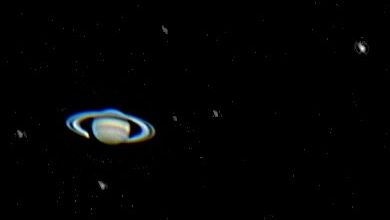 |
This is a composite, of course, of two exposures, one for the planet and one for the satellites. It is not one of my best but the night was not as clear as the forecasters had predicted and the Moon was nearly full. I have captured six satallites (use the mouseover to see their names). Two more, Hyperion and Enceladus are in frame, but I think Enceladus was too near the planet and was lost in its glare; Hyperion is faint and was lost in the general glow of the sky.
Date and Time: 10th May 2006 21:25 and 21:29 UT
Set-up: ToUcam 740K on the LX200 at prime focus
Capture: K3CCDTools. Planet: low gamma, high saturation, 1/25", 22% gain, 623 frames
Satellites: high gamma, B/W, 1/25", 70% gain, 699 frames
Processing: Registax. Planet: 282 frames stacked, wavelets 1-2 = 10, histogram 0-220
Satellites: 404 frames stacked, wavelets 1-2 = 10 gamma 2.0, brightness -26 and noise reduction in NeatImage.
|
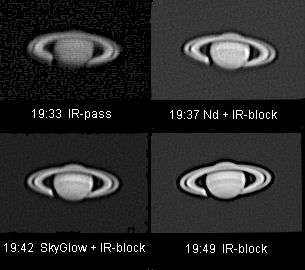 |
This is an experiment to see if I could image Saturn in daylight. The pictures were taken around sunset, which was at 19:41, on the same evening as the picture above. I used different filters which are indicated, along with the time, below each picture. I think it is interesting that the best picture is taken with a conventional IR-block filter with no light-polution filter. These pictures were taken around sunset and the sky was too bright to be able to see Saturn with the naked eye, but it could be distinguished in the telescope (even the finder). More amazing still was the fact that extreme stretching of the histogram on the fourth image revealed four of the satellites (Titan, Tethys, Dione, and Rhea).
Date and Time: 10th May 2006 19:33 to 19:49 UT (sunset 19:41 UT)
Set-up: ToUcam 740K on the LX200 at prime focus
Capture: K3CCDTools. Monochrome mode, low gamma, B/W, 1/25" with gain 56%, 5%, 15%, and 1/33 with 20% gain respectively, ~330 frames
Processing: Registax. Wavelets 1-2 = 10, histogram adjustments 50-200, 50-255, 30-200, 40-255 respectively. The final picture also has the gamma increased to 2.0, the contrast to 145, and the brighness to -50
|
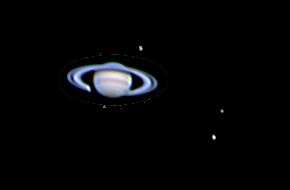 |
Again, I wasn't intending to image Saturn this night but I cannot resist it. Once again this is a composite of two images, one of the planet and one of the satellites. Move your mouse over the image to see which is which. Unfortunately, the brightest, Titan, was so far from the planet that I failed to notice that I didn't have it within the frame.
Date and Time: 5th May 2006 21:50 and 21:56 UT
Set-up: ToUcam 740K on the LX200 at prime focus
Capture: K3CCDTools. Planet: low gamma, high saturation, 1/25", 8% gain, 420 frames
Satellites: high gamma, B/W, 1/25", 8% gain, 452 frames
Processing: Registax. Planet: 243 frames stacked, wavelets 1 = 10, 2 = 7.5, histogram 0-215
Satellites: 223 frames stacked, wavelets 1-2 = 10.
|
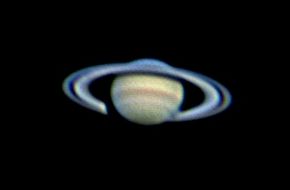
|
And this is an image made with my X2 lens attached the same night.
Date and Time: 5th May 2006 22:04 UT
Set-up: ToUcam 740K on the LX200 with X2 lens
Capture: K3CCDTools. Low gamma, high saturation, 1/25", 52% gain, 615 frames
Processing: Registax. 198 frames stacked, wavelets 1-3 = 10, histogram 30-240, blue 0.85.
|
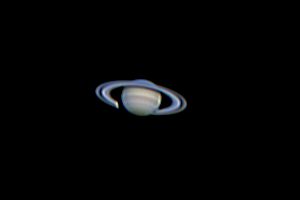 |
Once again, I wasn't intending to image Saturn on these two nights, but I can never resist the ringed planet. I was setting up prior to further experiments with auto-guiding, and I used Saturn for focusing
Move your mouse over either image to see a version enlarged by a factor of two.
The upper image was obtained on 25th April and the lower one on 3rd April. Both were captured at prime focus of my LX200.
Upper image:
Date and Time: 25th April 2006 20:04 UT
Set-up: ToUcam 740K on the LX200 at prime focus
Capture: K3CCDTools. Low gamma, high saturation, 1/33", 02% gain, 605 frames
Processing: Registax. 234 frames stacked, wavelets 1 = 15
Lower image:
Date and Time: 3rd April 2006 20:45 UT
Set-up: ToUcam 740K on the LX200 at prime focus
Capture: K3CCDTools. Low gamma, high saturation, 1/25", 0% gain, 717 frames
Processing: Registax. 346 frames stacked, wavelets 1 = 10, 2 = 5, gamma 1.1
|
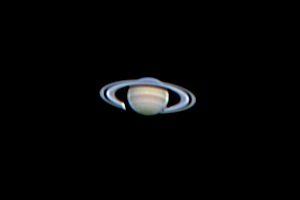
|
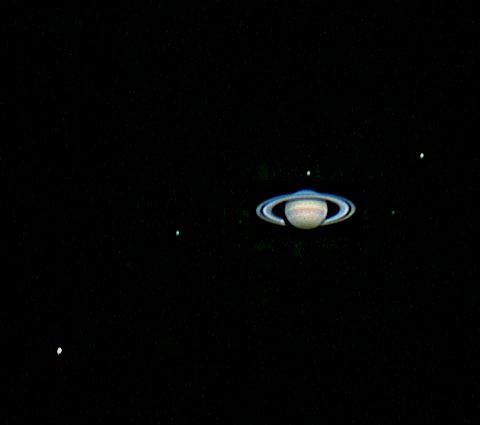 |
I wasn't intending to image Saturn that night. I was setting up prior to my first attempt at auto-guiding, and I used Saturn for focusing and to align my piggybacked ST80. Saturn looked good, so I grabbed a couple of AVIs but before I could get my X2 adaptor in place, the clouds came over and that was that for the night. However this is one of, if not the, best picture of Saturn I have got with my LX200 so far. With care you can see the Cassini division right around the rings.
Click on the image to see the image of Saturn enlarged by a factor of two.
The picture is, of course, a composite of two images, one of the planet and one of the satellites. Move your mouse over the image to see which satellite is which (and, yes, Mimas is there, just creeping through the noise). Due to the new, for me, set up of my equipment in order to try autoguiding, I failed to collect all the normal data on the exposures and so on. It was one of those nights!
Date and Time: 15th March 2006 20:58 and 21:04 UT
Set-up: ToUcam 740K on the LX200 at prime focus
Capture: K3CCDTools. Planet: low gamma, high saturation, 1/33", 88% gain, 592 frames
Satellites: high gamma, 456 frames (probably 1/25" at a high gain)
Processing: Registax. Planet: 222 frames stacked, wavelets 1 = 20, 2 = 10
Satellites: 223 frames stacked, wavelets 1-3 = 10.
|
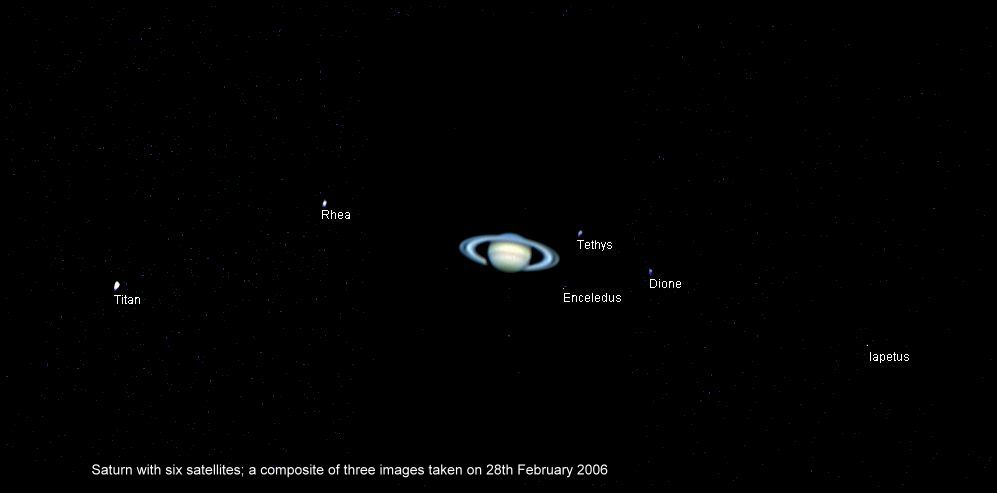
|
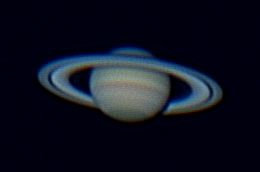 |
Another clear night but this one was taken at 04:50 local time and fog was beginning to form. Nevertheless a nice clear image.
Saturn was 1270 million kilometres (8.4 AU) away and subtended an angle of 19 sec of arc.
Date and Time: 11th December 2005 04:49 UT
Set-up: ToUcam 740K on the LX200 with X2 lens
Capture: K3CCDTools, low gamma, high saturation, 1/25", 78% gain, 1239 frames
Processing: K3CCDTools, 529 frames stacked.
Registax, wavelets 1-2 = 10.
|
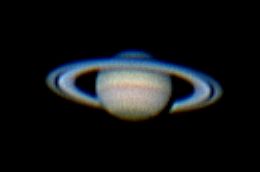 |
My third picture of Saturn in this season. Conditions were superb; not a cloud in sight and crystal clear. Saturn was high in the sky at 55°. The rings are slowly closing making the divisions more difficult to resolve, but do I just see a hint of the Enke minimum in ring B?
Saturn was 1360 million kilometres (8.8 AU) away and subtended an angle of 18 sec of arc.
Date and Time: 18th November 2005 04:33 UT
Set-up: ToUcam 740K on the LX200 with X2 lens
Capture: K3CCDTools, low gamma, high saturation, 1/25", 64% gain, 1032 frames
Processing: Registax, 165 frames stacked, wavelets 1 = 10 and 2,3 = 5, gamma 1.2, histogram 40-255, contrast 125. Followed by slight gaussian blur.
|
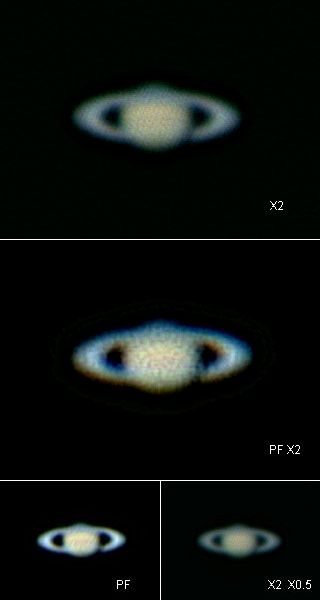 |
My second picture of Saturn in this season. Conditions were even worse than on the 28th September,
with Saturn at only 22°,
and this is a case of trying to "make a silk purse out of a sow's ear". I did two exposures this night,
10th October, one as usual with my X2 lens and the other at prime focus. The top picture here is the
best I could do with the first of these. The second is the image at prime focus, processed in Registax
as far as but not including the wavelet stage, exported to PhotoImpact where it was enlarged by a factor of 2.
This was then reloaded into Registax and the same wavelets applied as in the first picture.
This picture is not quite as good as I could get with slightly different wavelet processing (see below), but there
is not a lot in it.
Finally, the third and fourth pictures are the same idea, but the X2 image was reduced by a factor of
2 before applying the wavelet settings that gave the best picture for the image at prime focus.
Date and Time: 10th October 2005 02:26 and 02:56 (PF) UT
Set-up: ToUcam 740K on the LX200
Capture: K3CCDTools, low gamma, high saturation, 1/25", 60% and 28% (PF) gain, 697 and 305 (PF) frames
Processing: Registax, 158 and 51 (PF) frames stacked,
Top images wavelets 1,2 = 10 and 3 = 30. Lowest images wavelets 1,3 = 10 and 2 = 20.
|
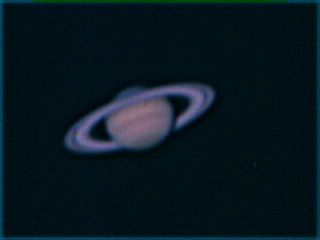 |
My first picture of Saturn in this season. It is not very good; Saturn was still quite
low in the sky (30°) and seeing was not particularly good. This picture was taken using a
Meade 3X barlow lens and (somewhat to my surprise) is better than the picture with my X2 teleadaptor lens.
The rings are beginning to close now and it is nice to see the north-polar area showing above the rings.
The distance to Saturn was 1440 million kilometres (9.6 AU).
Date and Time: 28th September 2005 03:58 UT
Set-up: ToUcam 740K on the LX200 with X3 barlow
Capture: K3CCDTools, low gamma, high saturation, 1/25", 88% gain, 547 frames
Processing: Registax, 173 frames stacked, wavelets 2-5 = 10, colours aligned, resized to 50%.
|

